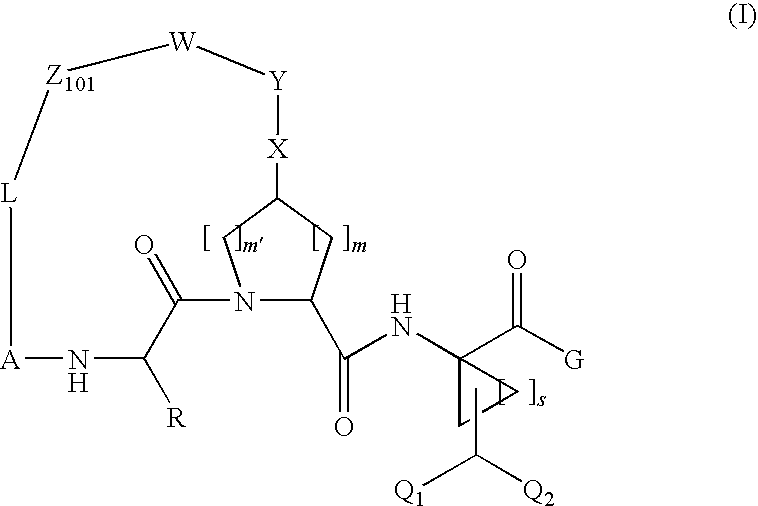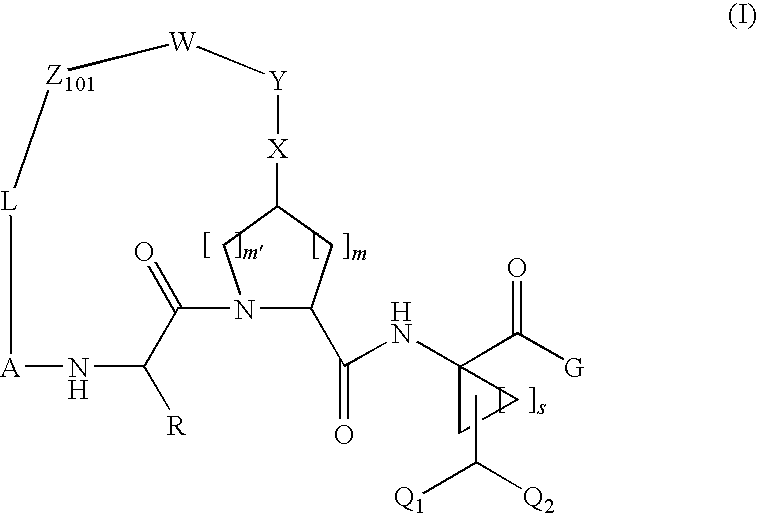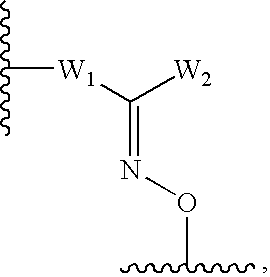Difluoromethyl-containing macrocyclic compounds as hepatitis c virus inhibitors
a technology of difluoromethyl and macrocyclic compounds, which is applied in the field of new hepatitis c virus protease inhibitor compounds and difluoromethyl-containing macrocyclic compounds, can solve the problems of interferon-related side effects, inability to reproduce infectious culture systems and small-animal models for hcv, and increasing public health problems
- Summary
- Abstract
- Description
- Claims
- Application Information
AI Technical Summary
Benefits of technology
Problems solved by technology
Method used
Image
Examples
example 1
Compound of Formula XI, Wherein
[0244]
[0245]Step 1A
[0246]A mixture of compound 1a-1 (0.84 g, 7.77 mmol), 1,2-diaminobenzene (2 g, 7.77 mmol) and ethanol (10 m) was heated under reflux for 2 h, cooled to room temperature, filtered, washed with cold ethanol and dried under reduced pressure to afford compound 1a (2.12 g) directly used in the next step.
[0247]Step 1B
[0248]To a mixture of the above 1a (1.02 g, 3.39 mmol), Boc-L-cis-hydroxyproline methyl ester (0.83 μg, 3.38 mmol) and triphenylphosphine (1.8 g, 6.86 mmol) in THF at 0° C. was added dropwise DIAD (1.33 ml, 6.76 mmol). The resulting mixture was held at 0° C. for 15 min. before being warmed to room temperature. After 18 hours, the mixture was concentrated under vacuum and the residue was purified by chromatography (Hexane / EtOAC=1:0 to 4:1) to give 1b (1.74 g). MS (ESI): m / e 528.02 (M+H).
[0249]Step 1C
[0250]To a mixture of compound 1b (0.6 g, 1 mmol), potassium vinyltrifluoroborate (0.52 g, 2 mmol), triethylamine (0.55 ml) and et...
example 2
Compound of Formula XIII, Wherein
[0281]
[0282]Step 2A
[0283]iPr2NEt (130 μL, 0.74 mmol) was added to 1f (195 mg, 0.37 mmol) in CH2Cl2 (2 mL), the resulting solution was added dropwise to a solution of FMOC-isothiocyanate (115 mg, 0.41 mmol) in CH2Cl2 (2 mL) at 0° C. The mixture was stirred at rt for 1 h and then treated with piperidine (20% in MeOH, 0.5 mL). After stirred for 12 h at rt, the mixture was concentrated, the residue was purified by silica gel chromatography to give desired product 2a (122 mg).
[0284]Step 2B
[0285]A solution of 2a (29 mg) and 1-bromohex-5-en-2-one (1.5 eq) in dioxane (1.5 mL) was stirred at 65 for 1.5 h. The solvents were removed and the residue was purified by silica gel chromatography to give desired product 2b (17 mg).
[0286]Step 2C
[0287]To a solution of 2b (17 mg) in CH2Cl2 (10 mL), was added Zhan 1B catalyst (5 mg). The mixture was stirred at 40° C. for 72 h. The solvents were removed and the residue was purified by silica gel chromatography to give desi...
example 189
[0292]The ability of compounds of the invention to inhibit NS3 / NS4a protease activity can be determined using the HCV protease activity assay described in published PCT application WO 2008 / 021956, the contents of which are incorporated herein by reference in their entirety.
[0293]The ability of compounds of the invention to inhibit HCV replication can be determined by using the cell-based replicon assay described in WO 2008 / 021956.
PUM
| Property | Measurement | Unit |
|---|---|---|
| temperature | aaaaa | aaaaa |
| temperature | aaaaa | aaaaa |
| pH | aaaaa | aaaaa |
Abstract
Description
Claims
Application Information
 Login to View More
Login to View More - R&D
- Intellectual Property
- Life Sciences
- Materials
- Tech Scout
- Unparalleled Data Quality
- Higher Quality Content
- 60% Fewer Hallucinations
Browse by: Latest US Patents, China's latest patents, Technical Efficacy Thesaurus, Application Domain, Technology Topic, Popular Technical Reports.
© 2025 PatSnap. All rights reserved.Legal|Privacy policy|Modern Slavery Act Transparency Statement|Sitemap|About US| Contact US: help@patsnap.com



